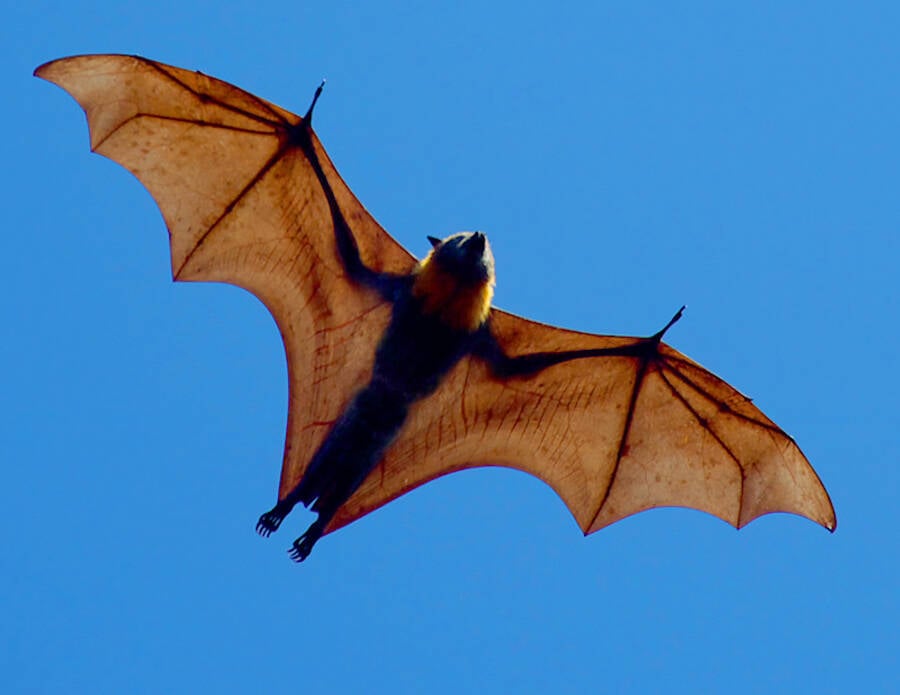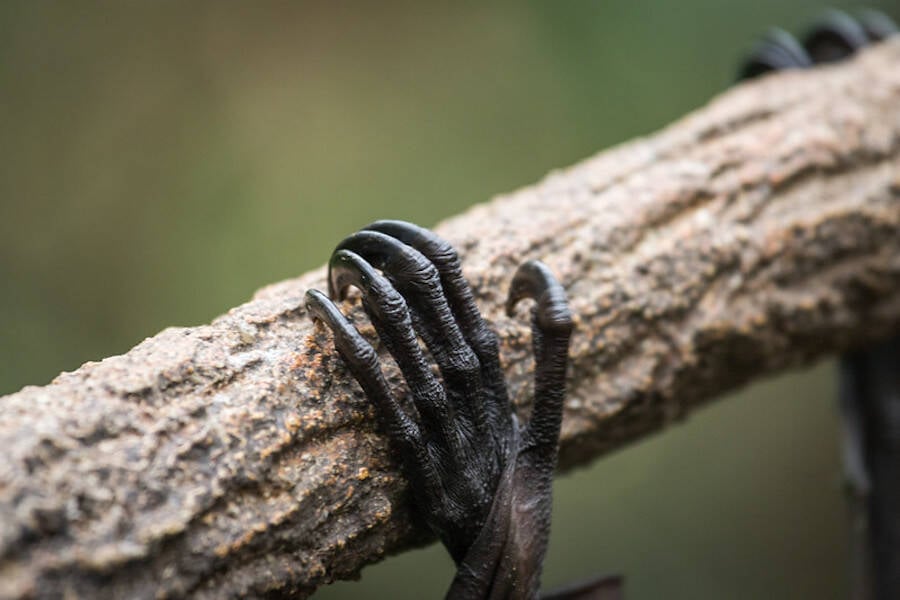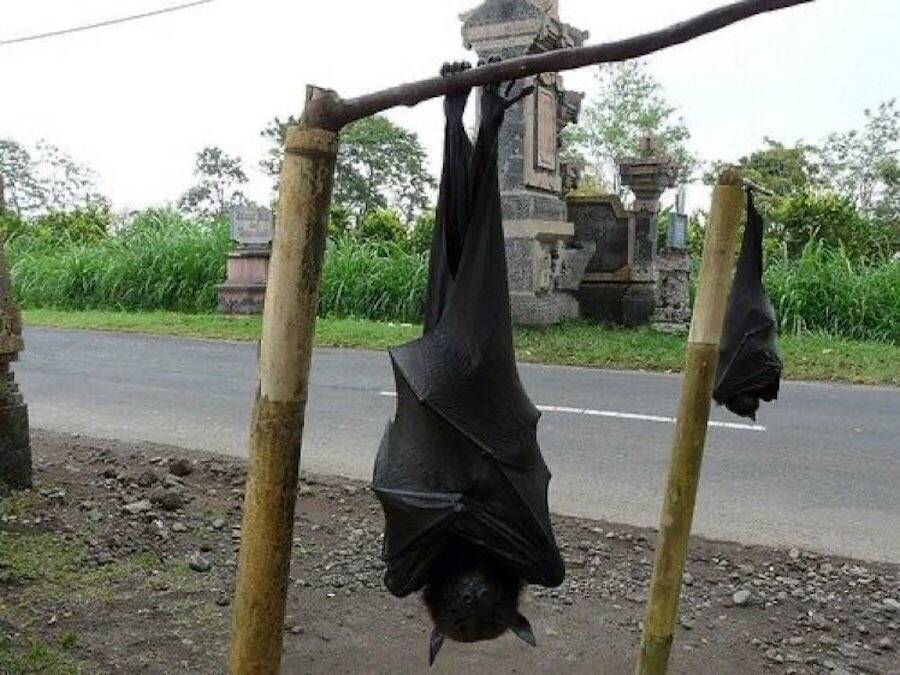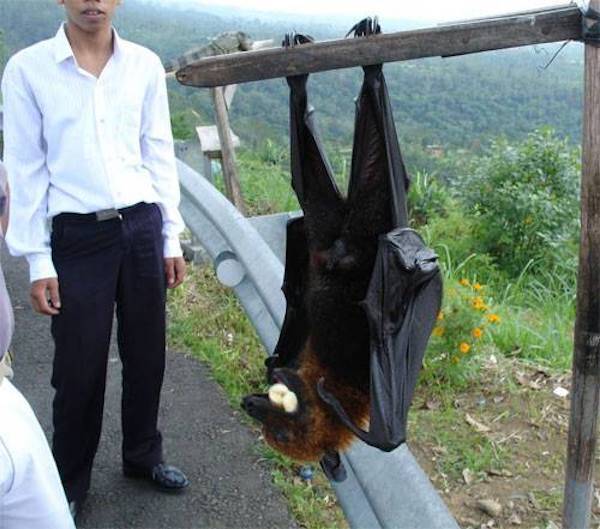Endemic to the Philippines, the giant golden-crowned flying fox is a nocturnal creature that only eats fruit — but that doesn't make them any less terrifying.
The notion of human-sized bats roaming the skies is genuinely nightmarish. Fortunately for us, the biggest bat in the world survives on a vegan diet of figs and other fruits.
Nonetheless, the giant golden-crowned flying fox’s size is truly something to behold — and viral images of these megabats have shocked social media users into sheer disbelief.

FlickrThe giant golden-crowned flying fox is the largest bat on Earth.
Endemic to the jungles of the Philippines, this enormous species of megabat is the largest bat in the world with a wingspan of up to five and a half feet and colonies that can number up to 10,000 members.
Ironically, these bats are rather harmless and pose no real danger to us — but human poaching and deforestation directly endanger the species.

RedditFortunately for us humans, this enormous species of bat is herbivorous and relies on figs and fruit to live.
What Is A Giant Golden-Crowned Flying Fox?
Though flying fox megabats live in Asia, Africa, and Australia, the giant golden-crowned flying fox (Acerodon jubatus) is found exclusively in the Philippines. The largest specimen of this fruit-eating megabat species has been recorded as having a wingspan of five feet and six inches, with a rather slight bodyweight of around 2.6 pounds.
Though its wingspan is wide, this bat’s body is small. Varying between seven and 11.4 inches, these seemingly terrifying creatures don’t even exceed one foot in terms of length.
Clearly, the world’s biggest bats didn’t evolve to snatch medium-sized animals off the ground. So what do they eat?

FlickrThe claws of a Malaysian flying fox, as it perches and roosts in the treetops.
The herbivorous creature relies mainly on fruits and typically forages at dusk for anything from figs to ficus leaves, eating around one-third of its body weight every night. During the day, it slumbers and roosts amidst large clumps of its peers in the treetops.
While its bloodless diet may come as a shock, only three out of 1,300 bat species are known to feast on blood.
Additionally, these bats are quite intelligent, comparable to domestic dogs. In one study, flying foxes were trained to pull a lever to get food, which they were then able to remember some three and a half years later.
Unlike many other bats, however, giant golden-crowned flying foxes don’t rely on echolocation to get around. These creatures use their sense of sight and smell to swoop around the skies remarkably well. Furthermore, they’re actually quite beneficial for the environment at large.

FlickrThe giant golden-crowned flying fox doesn’t mind roosting with other flying fox species, mainly the large flying fox.
The flying fox’s fruit-based diet helps propagate more of the plants they feed on. After eating, the flying fox redistributes fig seeds in its feces all over the forest, helping new fig trees to sprout.
Unfortunately, while the world’s biggest bat works tirelessly on reforestation, its two-legged enemy below works twice as hard at deforestation.
Hunting And The Habitat Of The Megabat
There are 79 bat species listed in the Philippines, of which 26 are megabats. As the largest bat in the world, the giant golden-crowned flying fox naturally trumps them all in terms of size.
Its genus includes four other megabat species in Southeast Asia, though it’s the only one spread across the Philippines. Unfortunately, their primary threats are all too common these days — deforestation and poaching for profit.
When left alone, this bat doesn’t shy away from human activity. They can be commonly found in forests near populated villages or towns, provided the laws against hunting them are adhered to and industrial activity is minimal. There’s no shortage of photos taken of these slumbering animals, perched along roads or comfortably dwelling on resort grounds.
On the other hand, disturbance and high hunting activity sees these animals retreat to thickly wooded forests to roost on inaccessible slopes more than 3,000 feet above sea level. Overall, the creature doesn’t mind roosting with other flying fox species, mainly the large flying fox.

TwitterThe giant golden-crowned flying fox garnered renewed interest after its shocking size went viral online.
Unfortunately, the continuous encroachment upon the animal’s habitat has seen it virtually disappear. To be clear, one can still find the giant golden-crowned flying fox all over the Philippines — but only in areas that are peaceful enough for it to let its guard down.
The Biggest Bat In The World Is Endangered
The destruction of its habitat and profit-driven hunting have seen the giant golden-crowned flying fox become an endangered species. The dwindling numbers in recent years are a clear sign that its very survival is being threatened.
More than 90 percent of the old-growth forests of the Philippines have been destroyed, forcing the species to abandon its natural roosting sites across multiple islands. On top of that, local communities hunt the bats — not merely for profit and sale, but for recreational and sporting reasons too.

RedditThese bats can reach a wingspan of up to five feet and six inches.
Fortunately, there are several non-profit organizations whose entire mission is to curb that problem. Bat Conservation International, for instance, works in tandem with two Filipino non-governmental organizations (NGOs) that have direct access to national and local government units that help out.
On the ground, some local communities protect roosting sites directly, while others work on educating their countrymen and women on the importance of helping this species survive. However, these enormous bats do pose one potential threat.

TwitterIf left undisturbed from poaching, the giant golden-crowned flying fox is rather comfortable near populated areas.
Though these bats are generally harmless, it is possible for them to carry and transmit diseases to humans. However, if left alone, it’s highly unlikely that bat-to-human infection would occur.
Threats And Conservation Of The Giant Golden-Crowned Flying Fox
The International Union for Conservation of Nature (IUCN) listed the giant golden-crowned flying fox as endangered in 2016 after the animal’s population declined by a whopping 50 percent from 1986 to 2016.
Sadly, hunting it for bushmeat continues to drive the golden-crowned flying fox population down. Even more troubling, the hunting practice itself is rather ineffective. Hunters shoot these animals out of their roosts, wounding more of them than necessary, as many who are killed don’t even fall from the trees.
As such, a poacher might kill up to 30 bats merely to recover 10. While terribly inhumane, poverty and desperation for food drive this practice. Deforestation, meanwhile, has seen the animal virtually disappear from the islands of Panay and Cebu.
While the species is protected by the 2001 Philippine Wildlife Resources Conservation and Protection Act, this law isn’t too stringently enforced. As such, the fact that the majority of the animal’s roosts are inside of protected areas doesn’t matter — as illegal hunting simply continues as usual.

FlickrAn Indian flying fox roaming for a treetop to roost in.
Ultimately, there are a few captive breeding programs that regionally attempt to maintain the species’ population. Whether or not these will suffice to keep the giant golden-crowned flying fox around for much longer is unclear, as the two primary causes of its endangerment continue uninterrupted.
After learning about the giant golden-crowned flying fox, the largest bat in the world, read about the Asian giant hornet, the bee-decapitating hornet that is the stuff of nightmares. Then, watch this stunning footage of the world’s largest animal eating.




